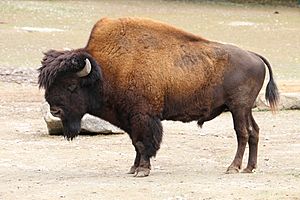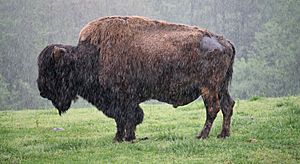Wood bison facts for kids
Quick facts for kids Wood bison |
|
|---|---|
 |
|
| A bull at Hellabrunn Zoo, Germany | |
| Conservation status | |
| Scientific classification |
|
| Kingdom: | Animalia |
| Phylum: | Chordata |
| Class: | Mammalia |
| Order: | Artiodactyla |
| Family: | Bovidae |
| Subfamily: | Bovinae |
| Genus: | Bison |
| Species: | |
| Subspecies: |
B. b. athabascae
|
| Trinomial name | |
| Bison bison athabascae Rhoads, 1897
|
|
The wood bison (Bison bison athabascae) is a special type of American bison. It's also known as the mountain bison or wood buffalo. These large animals live in the northern boreal forests of North America.
You can find them in places like Alaska, Yukon, and parts of Canada. They are an important part of the wildlife in these cold, forested areas.
Contents
What's in a Name? Bison or Buffalo?
You might hear these animals called "buffalo," but that name can be a bit confusing. True buffalo, like the water buffalo from Asia or the African buffalo, are only distantly related.
The word "bison" comes from a Greek word meaning "ox-like animal." The word "buffalo" comes from a French word, "bœufs," which also means ox or bullock. So, both names mean something similar!
Even though "bison" is more scientifically correct, "buffalo" has been used in North America since 1635. It's a very old and accepted name for these amazing animals. The American bison is also closely related to the European bison.
How Wood Bison Look

Wood bison are truly massive animals. They are larger and heavier than their cousins, the plains bison. A big male wood bison can be over 3 meters (11 feet) long. They can stand over 2 meters (6.5 feet) tall at the shoulder. Some can weigh as much as 1,179 kilograms (2,600 pounds)!
This makes them one of the biggest land animals in North America and Siberia today. Their highest point is in front of their legs, unlike plains bison whose highest point is right above their front legs.
Wood bison also have bigger horns and darker, woollier fur. They have less hair on their front legs and smaller, more pointed beards. Plains bison, however, can run faster, reaching speeds of up to 64 kilometers per hour (40 mph).
Some wood bison today might have mixed genes from plains bison. This happened because plains bison were moved into wood bison areas a long time ago. However, some herds still look very much like the original wood bison.
Dangers to Wood Bison
Wood bison populations faced huge challenges in the past. Hunting and other problems almost made them disappear by the early 1900s.
Mixing Genes and Diseases
One big problem for wood bison was mixing with plains bison. Between 1925 and 1928, many plains bison were moved into Wood Buffalo National Park. This was done to prevent them from being culled due to overpopulation.
However, these plains bison carried diseases like brucellosis and tuberculosis. They also mixed their genes with the wood bison. This was a big worry for scientists trying to protect the pure wood bison.
Luckily, in 1957, a group of about 200 wood bison was found. They were in an isolated part of Wood Buffalo National Park and were thought to be quite pure.
Diseases like brucellosis and tuberculosis are still a problem for some wild herds. These diseases can spread to other animals, including cattle. Scientists and governments are working hard to manage these health issues.
Protecting Wood Bison
Thanks to a lot of hard work, wood bison populations are growing again. There are now around 2,500 wood bison in total. In 1988, their conservation status was changed from "endangered" to "threatened."
Bringing Bison Back to Alaska
In 2008, 53 Canadian wood bison were moved to Alaska. They stayed at the Alaska Wildlife Conservation Center for a while. The plan was to reintroduce them to their native lands near Fairbanks.
This plan finally happened in 2015. The Alaska Department of Fish and Game released 100 wood bison into the Innoko River area. This was a big step in bringing these animals back to their original homes.
Bison Return to Asia
Interestingly, wood bison are also being reintroduced to Yakutia, Russia. This area is where their ancient relatives, the steppe bison, lived thousands of years ago.
In 2006, a group of wood bison was sent from Canada to Russia. More bison were sent in 2011, 2013, and 2020. By 2019, the number of bison in Russia had grown to over 210 animals. Some have even been released into the wild.
Today, about 7,000 wood bison live in the wild. You can find them in the Northwest Territories, Yukon, British Columbia, Alberta, and Manitoba. Scientists are even exploring ideas like bringing back ancient bison using cloning!
Gallery
-
Wood bison (not pure) in Wood Buffalo National Park
See also
 In Spanish: Bisonte americano de bosque para niños
In Spanish: Bisonte americano de bosque para niños







